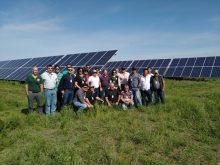The St. Mary River Irrigation District is putting the sun to work providing water to its users. Solar arrays at two large pump stations have the district in a position to achieve net zero electrical use — and potentially save hundreds of thousands in electricity costs down the road.
The inspiration to look at solar came from farmers, said Trevor Helwig, the district’s technical services manager.

“Solar arrays were being implemented successfully by irrigators at the farm level before we proceeded, including a few of our board members,” said Helwig.
But the scale was considerably different.
The St. Mary River Irrigation District services about 400,000 acres of irrigated land through about 2,000 kilometres of canals and pipelines between Medicine Hat and Lethbridge. It has three large pump stations and although the amount varies annually, they use a lot of power — 2.2 million kWh to 4.97 million kWh yearly from 2017 to 2019.
The bill is equally big — $379,000 to $787,000 a year — while the district’s electric bill for all the buildings and other infrastructure is much less at $125,000 annually.
But the district now has a goal to achieve net zero on electrical use. Net zero means the district will generate the same amount of electricity it uses on a yearly basis by feeding surplus power into the electrical grid, and drawing from the grid when its power needs are greater than what the solar panels generate.

A question that often comes up is, ‘Why try to offset electricity when users must still pay transmission and delivery fees?’ Over the past decade, the rate per kWh has gone down, but transmission and delivery fees have more than doubled.
“Rate 26 is your electricity rate for irrigation,” Helwig told attendees at the Alberta Irrigation District Association conference this winter. “It ties transmission and distribution to your usage. If you can get your usage down by using solar, you’re reducing that portion of your bill on that (transmission and delivery) side as well.”
This special rate consideration, combined with the high electricity demands, make solar a boon for irrigation.
But officials at St. Mary River Irrigation District made sure there was a strong business case for solar energy and that its water users would not incur any additional costs due to the installation of solar arrays. They worked with Enmax and modelled various scenarios based on the past eight years of electricity use and prices. They determined that it was viable, and that a 15-year lease through Enmax was the best option for covering the capital costs. (The district also received a provincial grant, from Energy Efficiency Alberta, covering 35 per cent of the capital costs.)
Read Also

Farming Smarter receives financial boost from Alberta government for potato research
Farming Smarter near Lethbridge got a boost to its research equipment, thanks to the Alberta government’s increase in funding for research associations.
Solar arrays will be operational at two pump stations in 2020.
Bow Island 12 pump station serves a 4,000-acre system south of Bow Island. The station provides 80 psi at the pivot points for the water users on that system so they don’t require pumps at their pivot points. The 40 Mile pump station moves water from a storage reservoir to the district’s main canal.
The Bow Island 12 site has a 700KW solar array located along the district’s main canal.
“We used trackers at this location to reduce the amount of area that was required,” said Helwig.
Trackers increase the efficiency of the system by changing the axis of the solar array according to the position of the sun. The panels also have a wind speed detector so they self-level to reduce the potential for damage during times of high winds.
The 40 Mile pump station has a 1.74MW fixed axis solar array, which is also situated on district land.
Both systems are classed as micro-generators.
“A large micro-generator means greater than 150KW but less than 5MW,” said Helwig. “If you’re greater than 150KW you’re paid the hourly pool price. If you’re less than 150KW you have the choice of being paid out the commercial rate or the hourly pool price.”
The pool price is a variable rate determined hourly by supply and demand, and generally sits around the range of $40 to $50 per MWh. (Based on its business case modelling, district officials estimated the break-even was, on average, about $45/MWh.)
Once the 15-year lease is up, the cost savings will go to the bottom line as long as the arrays are working well and not costing a lot in maintenance or repairs.
“The concerns we have are related to long-term costs,” said Helwig. “Will there be damage from wind and hail et cetera? But we have insurance to cover that, and we’ve got a really good warranty from the supplier and the installer. We’re good for 25 years long-term warranty from supplier and 15-year workmanship warranty with Enmax.”
The arrays come with a guarantee of 80 per cent output in 25 years’ time.
“We acknowledge that there will be a loss of about 0.8 per cent production every year,” Helwig said. “Twenty-five years from now we expect to see 80 per cent output from what we will see in year one. We expect the panels to last over 30 years, but we understand that there will be that loss in output over time.”
The district also installed solar panels on its office and shops in the past year.
“Most years the financial benefits of having the solar panels in place exceeds or will at least match what we’re paying for electricity as if the panels weren’t there,” said Helwig. “So we feel that’s a good investment. We’re happy that we’re able to install them and lease them over the 15 years without having to have any upfront costs to the water users.”














